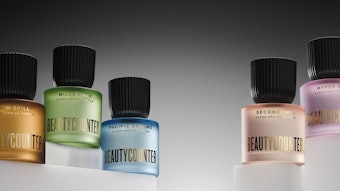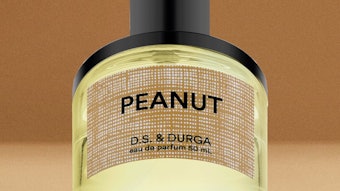The home fragrance market continues to respond to consumer demand. New concepts, materials and diffusing systems have spurred growth, while aesthetics plus the desire for clean home freshness have broadened product appeal. Marketers continue to offer sensory-oriented introductions, with favorites like candles, scent sticks and oils remaining strong, while seeking reinvention.
The global air care market was valued at $7 billion in 2006, with U.S. value recorded at $2.5 billion, according to Euromonitor International. These figures include sales in spray and aerosol air fresheners, electric air fresheners, gels, liquid and candle fresheners, as well as car fresheners and other household air care. Global spray and aerosol air fresheners reached $2 billion, with candle air freshener sales reaching $606 million in global retail. Clearly, the market is showing demand for products that freshen and fragrance homes, with U.S. air care sales growth placed at 7% in 2006. These U.S. consumers are drawn to air care for several reasons, not the least of which is a busy lifestyle that translates into less at-home cleaning, irregular pet ownership and the desire to create ambiance. In response, companies have launched products like Glade Scented Oil Candles, and imagery-driven items, like Febreze Scentstories, which offers a variety of ambient options on disc.
A new wave of scented products has resonated with customers seeking particular atmospheres in their homes, including clean laundry scents, like fresh linen, citrus and rain; comforting food scents; or scents suggesting the outdoors. Candle air fresheners have been a strong growth area, but also face competition from traditional scented candles, which many consumers find to be aesthetically pleasing.
Electric air freshener sales have been strong, showing 10% growth in 2006, says Euromonitor, fueled by Febreze Noticeables by Procter & Gamble and Glade Plug-Ins Scented Oil Light Show by SC Johnson. Febreze Noticeables, a plug-in scent oil warmer, offers two complimentary scents that alternate automatically throughout the day. The company says the device is designed to combat the phenomenon known as habitualization, which occurs when the nose adapts to a single scent and no longer notices it. Glade Plug-Ins Scented Oil Light Show also made news as the first air freshener aimed at tweens and teenagers, offering a choice of fragrance and colors.
Expressive Palette
Fragrance in the home continues to be an expressive palette through which cultural and emotional phenomena may be expressed. “The home fragrance market has been the shining star of the scent business. It has continued to post gains with new fragrances, new delivery systems and new retail opportunities, engaging today’s wily consumer in the fragrance game,” said Virginia Bonofiglio, Fashion Institute of Technology.
Bonofiglio noted the trickle-down phenomenon that pervaded the industry for years, in which fragrances were created and marketed for feminine and masculine colognes. “Over time, these fragrances are translated through cost-reductions and structure reformulation into fragrances for other product categories, from personal care to home care. This is where most home fragrances had their beginnings. During the past decade we have experienced a reversal of this phenomenon,” she said, calling it the “trickle-up effect.” Fragrance types, which have long enjoyed success in the home fragrance category, like vanilla, marshmallow, butter cream and crème brulée, have found their way into the fine fragrance arena. “These successful candle scents now form the basis of the gourmand category of colognes. They bring a rich warmth and playful touch to fine fragrances. We can expect to see these gourmand fine fragrance scents return to the home fragrance category as more sophisticated edible aromas with marmalade accords, confit notes, or a hint of chocolate ganache in the base note,” added Bonofiglio.
As the home care category has expanded, there has been a new call for fragrance performance. “The consumer wants to clean the air in a hurry,” said Bonofiglio, “hence, a new need has been created. The scent left in a room needs to be eliminated before a new one is introduced, so there is a need to ‘cleanse the palate.’ We used to call this odor counteraction, and the objective was to eliminate malodors. The goal today is far more refined, eliminating leftover scent in the air prior to inserting a new scent, so that the new home fragrance can be appreciated without any olfactive interference.”
Bonofiglio believes home fragrances are as trend-driven as all consumer products. “We can expect a global viewpoint, new eco-consciousness and corporate philanthropy to motivate fragrance choices and delivery systems. Terms such as recyclable, green, organic, carbon footprint, sustainability, wellness benefits and natural functionality will find their way into the home fragrance lexicon.”
In addition, an expectation of recycled or recyclable packaging, natural and organic bases, all natural and organic fragrances, labels defining the carbon footprint of the product, natural functionality and corporate charity support will impact the market. “New green scents will appear to subliminally inform the consumer that [the company is] aware of environmental issues. Exotic fruit notes will emerge to capture the imagination of the well-read, well-traveled consumer. Pairings of hot and cold notes and sweet and sour notes will expand as we head to the garden and investigate combinations found in India, Africa and the Caribbean for inspiration,” said Bonofiglio. Global influences will continue to be an infinite source of inspiration, and as long as ideas, raw material sources and creativity thrive, many fragrant delights will appear on the home fragrance horizon.
Perfumers’ Perspective
Changing the feel of a room, as well as changing an individual’s mood, are key drivers in home fragrance today, according to Shardona Daneshvari, International Flavors and Fragrances (IFF). “Home fragrance is an integrated element of everyday life. There is a self-indulgence aspect, when a fragrance reminds someone of a special treat or indulgence, albeit without the calories.”
Hence, dual function is a definite trend in the marketplace, with reed diffusers, bamboo sticks, and eco-friendly and natural materials as popular trend forms. “Home fragrance has two aspects, one is for problem solution and another is for ambiance. However, the two mediums are beginning to blend. Glade Air Infusions, for example, has aesthetic appeal as well as function; and candles are starting to include odor-eliminating properties,” said Daneshvari, citing Febreze by P&G, as well as Oust, by SC Johnson, as examples.
Regarding the future, fresh fragrance will be a strong performer. “We’re seeking water fresh fragrances through fruits, flowers, and herbs that are hydroponically grown, and therefore exclude any influences that are found in the soil. This results in the most pure, fresh and clean fragrances,” she added.
The strongest trend areas she cited were freshness and fragrances reminiscent of indulgent, decadent pleasures. “We also see inspiration from the world of flavors, like juicy tropicals, watery fruits, zesty citruses and rich berries. In terms of fruit trends, there’s a trend toward healthy fruits, including blueberries, raspberries, pomegranate and acai berry, rich in antioxidants,” she said. Trends from flavors to health and wellness have made their way to both fine fragrance and home fragrance, providing a wide variety of choices.
While consumers find unusual and culturally resonant fragrance options, perfumers and marketing professionals stay on-trend with ingredient selections, sourcing and the emotional stories they convey. According to Greg Weiss and Dave Niemera, perfumers with Firmenich, “There are several key factors considered in creating an air care fragrance. Primary importance is client and consumer knowledge. For example, for Yankee Candle, it is important to understand the Yankee consumer in terms of their expectations from a fragrance standpoint. In Yankee’s case, there’s an expectation of comfort and warmth across all their fragrances. For other clients, the expectation might be a literal translation of the fragrance name with high impact. So, creative development needs to translate these consumer expectations to the client across all fragrances.”
Technical construction is also important, as the fragrance must perform in synchronization with the technical application of the product, like a liquid electrical plug-in, a non-electric gel diffuser or an aerosol. “Evaporation rates of various components are considered, and compatibility of fragrance components with packaging components is also an important consideration. Duration of fragrance performance must be taken into account to meet specific product claims, as well,” added Weiss and Niemera.
Naturals; Luxury Impact Form
In the natural arena, formulating fragrances with essential oils, nature-based scents, and recyclable, more natural-looking packaging is gaining in popularity. “Capturing the essences of nature in fragrance, soy-based wax for candles, solar powered diffusers in place of batteries and electricity, and trying to be more eco-friendly in fragrance claims, packaging and marketing claims, are a growth trend,” he noted. Consumers are drawn to new devices in search of improved performance and have more control regarding selections, formats, and fragrance options.
Home fragrance as a luxurious accoutrement also finds expression in upscale scents and presentations. Roger&Gallet chose the citron fruit from southern Italy, to compose Cédrat, for its fragrant water, and translated it into a perfumed candle. Citron was discovered in the Far East and recognized as “the hand of Buddha,” regarded as a symbol of life and happiness. The luxury candle delicately perfumes the home with a blend of fresh Calabrian citrus, aromatic and woody notes, adding sparkle and modernity to the air.
Recently, Manuel Canovas, the international French fabric house, launched nine fragrances for the home, based on inspirations from the designer’s own childhood, including Indian art, Japanese graphics, nature, American folk art and the Far East. The refined scents, available in candles and natural room sprays, create an elegant home atmosphere reminiscent of Canovas’ luxurious weaves.
The hand-crafted candles, made of high-quality, non-allergenic waxes, with lead-free wicks, as well as the natural room sprays, are available in Jardin de Lantana, with verbena, lantana, and mango; Bois de Lune, with velvety notes of red cedar, rosewood, Chinese Tea and wild berries; Fleur de Coton, featuring green and pastoral notes, with linden flower, and morning dew; and Matin de Perles, with peony, forget-me-not, and acacia wood, representative of the fresh and natural essences comprising the line.
With on-trend scents, and a wide variety of dispensing options available for the home, consumers can express their individual tastes to create ambiance, as well as their moods of the moment. Home fragrances continue to be among the most popular aspects of the fragrance market, with reinvention and scent translation key components.










